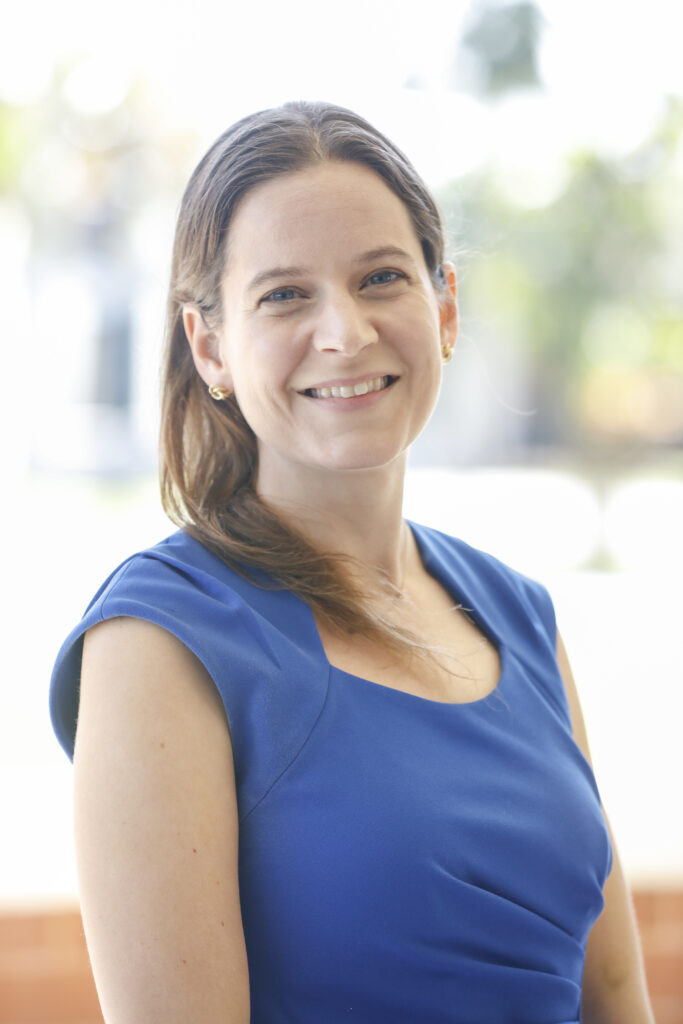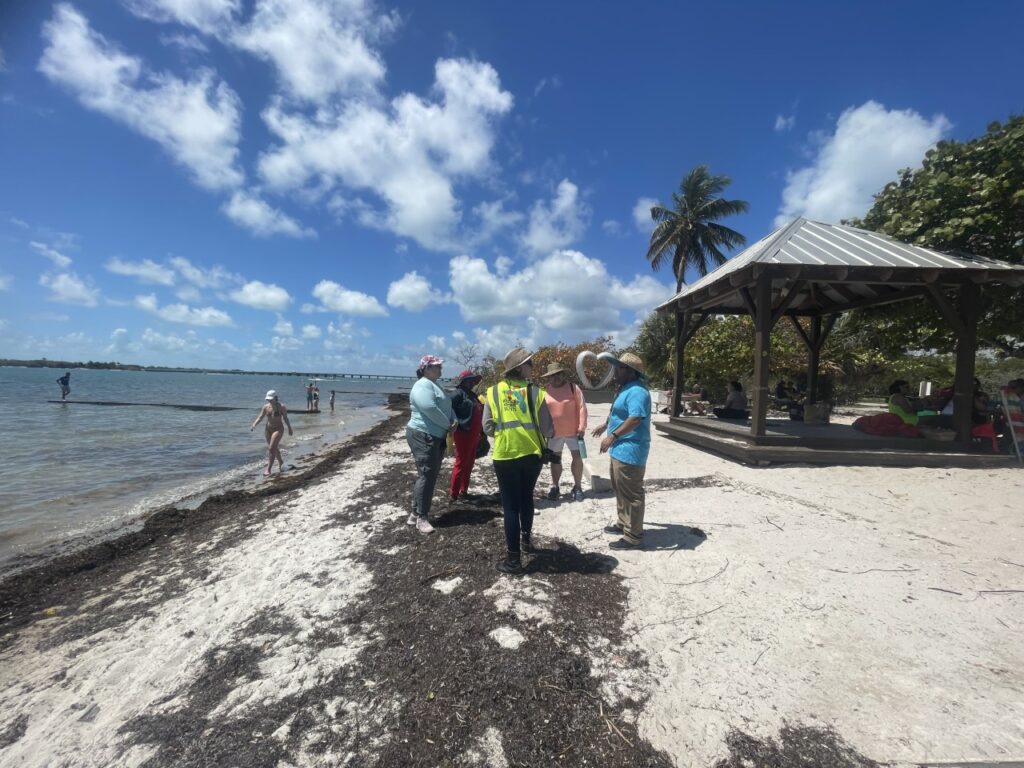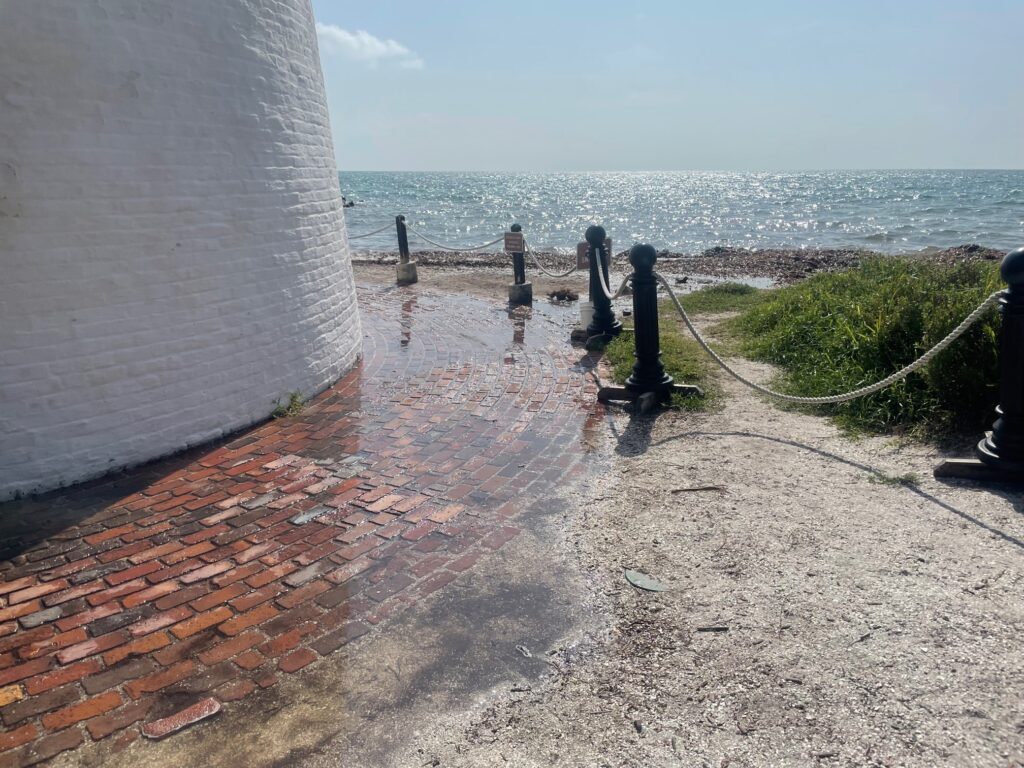By Laurie Mermet, The Invading Sea
The following Q&A was conducted with Sara Ayers-Rigsby, director for the Florida Public Archaeology Network’s Southeast/Southwest regions. The Florida Public Archaeology Network is a statewide educational organization, which offers educational programs and online training to raise awareness and involve the public in preservation efforts. This interview has been edited for length and clarity.
What initially got you into archaeology?
I have wanted to be an archaeologist ever since I was a little girl. My parents would take me to museums and read books about archaeology. I always joke that I am remedying a family curse. I think my grandfather wanted to be an archaeologist and didn’t wind up doing that. And my mom also wanted to be an archaeologist. So I feel like I’m doing right by my family by becoming an archaeologist.
Could you tell me a bit about the impact of climate change on historic and archeological resources? How big of an issue is this and can you provide some examples?

Climate change, just like it’s an issue for our houses and our current modern infrastructure, climate change is also an issue that’s impacting our past and our archaeological and historical and cultural sites. So, a 3-foot rise in sea level, which is predicted by some metrics … that could impact over 15,000 sites in Florida. That means sites that are now terrestrial are now eroding because there’s some water over them.
Some sites may become totally submerged. It’s an issue for our underwater sites as well. Even though you might think, “They’re underwater already,” when we think about factors like warming oceans and increasing ocean acidity, those are going to affect the very delicate balance and chemistry of those underwater sites.
Our sites that are on land can experience impacts like increased flooding and other sites can experience impacts to visitation. If you think about a site that’s documented and interpreted for the public, maybe the parking lot where people could park, if that’s flooding all the time due to king tides due to sea level rise, that’s going to be an issue. That means that people aren’t going to be visiting that site and learning about it.
What are some of the most vulnerable archaeological or historic sites in the state, and why are they at risk?
I do a lot of work up at the Jupiter Inlet Lighthouse Outstanding Natural Area. It has a lot of different phases of occupation, so everything from about 5,000 years ago to historic buildings that were constructed on the site during World War II, and then after World War II when the Coast Guard was using the site. …
The southern shoreline of the site was experiencing really significant erosion. It was eroding at a rate of about 4 feet per year, and that entire southern section of the site has an archaeological component. FAU’s geomatics department … went out and did some drone photogrammetry to get that number. They were calculating how much was being lost every year. …
That information, and then us really advocating for the archaeology of the site, led the Bureau of Land Management to work with the Jupiter Inlet district and other partners to build a living shoreline at the site. Now, instead of the site eroding by 4 feet a year, it’s actually accreting a little bit. So it’s gaining (about) a centimeter … a year.
I like to talk about that story because it’s really easy to get very depressed when we think about climate change, especially when we think about climate change impacting these sites that have existed for so long , so it makes me feel nice that there are successes possible. It may not be possible to build a living shoreline for every site, but it’s possible to build it for some.
What strategies and technologies are currently being used to protect these vulnerable sites from climate change?
When we think about some of our historic structures, a famous example is the Cape Hatteras lighthouse, which they’ve actually moved inland a couple of times. So if you think about the logistics of moving a lighthouse, for standing structures, it may be possible to move them.
For some sites, it might be possible to do living shorelines. But for a lot of these sites, it may not be possible to really take any protective action, and then we have to look at how we can use the story of that site being destroyed to raise more awareness about climate change and to raise more awareness about archaeology, so to try and use the site as a learning opportunity. …
You’re involved in a statewide network aimed at protecting these sites. Can you tell us more about this network and its goals?

I work for the Florida Public Archaeology Network, which is established by state statute. We are a statewide educational organization. We’re actually established by state statutes, so legally, the state of Florida has to maintain a network of public archaeology centers. Our mission is public outreach and education, so it’s to raise awareness about the importance of stewardship, public appreciation and value of Florida’s archaeological past. So the mission is incredibly broad.
The program is administered by the University of West Florida, and then they have different partner universities with different regions across the state. FAU is the partner for the Southeast and Southwest region. I’m the director for the Southeast and Southwest so that means everything south of (Lake Okeechobee). ….
We do different programs where we encourage people to document and record and clean historic cemeteries, so we do workshops on that. We do public education events, so things like public lectures for adults, and then merit badges with the Scouts of America. …We’re just trying to get people out and aware of the archaeological resources that are out here in Florida.
Last month, we launched our online training through Canvas for the (Heritage Monitoring Scouts) program. Before, we had always done in-person trainings where people would come up and attend a workshop, and the workshop modules (include) the science of climate change, laws that are protecting archaeological sites, basic (tutorials for) how to recognize archaeological material.
How can members of the public get involved in protecting archaeological and historic sites, especially through your new online training program?
The information for our program is available at our website (www.fpan.us). … I would definitely say that they can go to that site and get more information about the program and how to get involved in that. And then we are sending people out to archaeological sites, where we have approval from the state to have volunteers actually go out and document the impacts to that site.
It’s really helpful for us because even though there are 20 of us, there are 16,000 sites that are expected to be impacted… . So the more help we can get, the better. And then I would also really encourage people to attend local meetings for their historic preservation board. …
How do you foresee climate change continuing to affect these sites over the next decade or more?

I think climate change is clearly going to have a deleterious effect on these sites. We’re going to have erosion of coastal sites as water levels encroach on the site. We are going to have reduced access to sites as roadways and other areas flood. Obviously, when a hurricane comes through, that’s not great for an archeological site, and there’s other factors as well that we have to consider.
For example, groundwater coming up through an archeological site could destabilize the archeological site or mean that as we’re excavating deeper, we’re not able to get below a certain portion of the site because it’ll be submerged even though in the past that area would have been dry. And the other concern that we have is of course as archeologists we’re workers who work outside, so with increased heat it makes it much more dangerous for us to do our jobs as well. That’s a big concern I have, is how do we do this work safely throughout the year?
What gives you hope in your work, despite the challenges posed by climate change?
Seeing people really get behind a site. Sometimes it can be for a negative reason like after Hurricane Ian and after Hurricane Irma. We had the community really rally around sites because these sites are being destroyed or exposed so that can lead to a renewed interest, so I’m really happy that people care about the sites and that gives me a lot of hope too of working with volunteers for our (Heritage Monitoring Scouts) program. …
It makes you feel like you’re not alone in doing this work. You’re just one of a group of people that is really passionate about documenting and trying to preserve some of these sites.
Do these volunteers have to already be generally involved in archeology or can they be anyone?
It can be anyone. We train people and give them a basic understanding of archeology and then we’re always happy to go out with people until they feel confident enough to go out on their own.
This Q&A was conducted by Laurie Mermet, a Florida Atlantic University senior majoring in multimedia journalism who is reporting for The Invading Sea during the fall 2024 semester. Banner photo: Jupiter Inlet Lighthouse Outstanding Natural Area (iStock image).
Sign up for The Invading Sea newsletter by visiting here. If you are interested in submitting an opinion piece to The Invading Sea, email Editor Nathan Crabbe at ncrabbe@fau.edu. To learn more about king tides, watch the video below.



